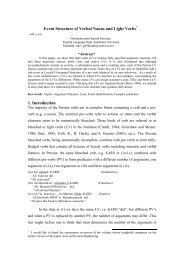Separability of Light Verb Constructions in Persian*
Separability of Light Verb Constructions in Persian*
Separability of Light Verb Constructions in Persian*
Create successful ePaper yourself
Turn your PDF publications into a flip-book with our unique Google optimized e-Paper software.
lexicon or syntax and the <strong>in</strong>ternal structure <strong>of</strong> cases like (4) and (5) is not visible to the<br />
syntax? How do some PVs sometimes function as parts <strong>of</strong> predicates (3a) and sometimes<br />
as DP arguments play<strong>in</strong>g the role <strong>of</strong> direct object? We have <strong>in</strong>troduced the significant<br />
data and issues related to this work present section. The general properties <strong>of</strong> LVCs <strong>in</strong><br />
Persian are presented <strong>in</strong> section {2}. In section {3}, the components <strong>of</strong> LVCs and their<br />
characteristics are expla<strong>in</strong>ed. The (<strong>in</strong>)separability <strong>of</strong> LVCs is particularly focused on <strong>in</strong><br />
section {4}. The conclud<strong>in</strong>g theoretical remarks <strong>of</strong> the paper are summarized <strong>in</strong> section<br />
{5}.<br />
2. <strong>Light</strong> <strong>Verb</strong> <strong>Constructions</strong><br />
Persian LVCs have attracted a number <strong>of</strong> researchers (Mohammad and Karimi,<br />
1992; Vahedi-Langroudi, 1996; Karimi, 1987; Karimi Doostan, 1997; Dabir-Moghadam,<br />
1995). More recently, Megerdoomian (2001) and Folli, Harley and Karimi (2005) have<br />
ma<strong>in</strong>ly focused on event structure and aspectual properties <strong>of</strong> Persian LVCs; while <strong>in</strong><br />
Megerdoomian (2001) the LVs, <strong>in</strong> Folli, Harley and Karimi (2005) the VNs play an<br />
important role <strong>in</strong> determ<strong>in</strong><strong>in</strong>g the aspectual properties <strong>of</strong> LVCs. Both approaches claim<br />
that Persian LVCs can be accounted for syntactically and f<strong>in</strong>d it difficult to consider these<br />
complex verbs as lexical units. They attempt to expla<strong>in</strong> the <strong>in</strong>ternal structure <strong>of</strong> Persian<br />
LVCs <strong>in</strong> the light <strong>of</strong> Hale and Keyser's (1993, 2002) lexical-syntax approach to verb<br />
formation. A considerable number <strong>of</strong> complex predicates <strong>in</strong>clud<strong>in</strong>g those focused on <strong>in</strong><br />
this work are taken <strong>in</strong>to consideration <strong>in</strong> both works and they take the position that the<br />
LVs are responsible for agentive arguments. Goldberg (2003) argues that Persian LVC is<br />
a zero level verb (V0) by default and whether LVC is expressed as a zero level verb or as<br />
a phrasal entity is determ<strong>in</strong>ed by <strong>in</strong>dependently motivated constructions. Default V0<br />
status accounts for the CP’s zero level properties <strong>in</strong>clud<strong>in</strong>g its resistance to separation<br />
5



